Overalls for chefs: features, varieties, subtleties of choice

A chef is an employee of a catering establishment, so he must not only cook well, but also have an impeccable appearance. For this, there is a special uniform, which is convenient and practical, and is also able to protect the products used during cooking from contamination. We will talk about the features of work clothes for cooks, its main types and selection rules in our article.

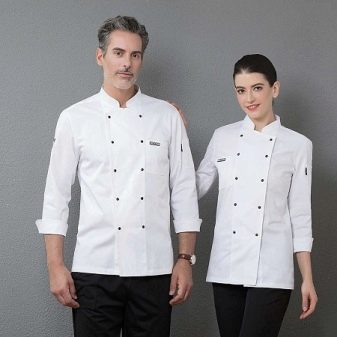
Peculiarities
The main requirements for overalls for a cook are cleanliness, comfort and safety. She should have all these characteristics. And also when choosing, you need to take into account the environmental friendliness of manufacturing materials. Chefs work in humid and rather high-temperature conditions, so synthetic fabrics are completely unsuitable for such work. In addition, the wear resistance of the workwear matters. The work uniform has to be washed almost daily, but this should not affect its appearance. Some members of this profession consider it very important that it does not require ironing.
It should be noted that the work of a cook will not be complete without the appearance of stains on clothes.... This fact may require exposure to harsh detergents to help remove contamination.
Quality materials should tolerate contact with them well. And also all sorts of mechanical influences are possible, therefore the density and strength of the clothes are very important.


What is it used for?
The cook's uniform is designed to make working at the stove comfortable and safe for its owner. That's why the rules for wearing it are specified in the sanitary rules and regulations (SanPiN). In addition, some consider overalls for chefs to be an unnecessary whim of employers or regulatory authorities. It must be said that this position is erroneous. Uniforms help maintain cleanliness and hygiene in the workplace. It prevents all kinds of contaminants, such as hair and sweat, from entering food. It should be worn not only by chefs, but by all other kitchen workers. This is an integral part of the restaurant's reputation, as it affects the health of its visitors and aesthetics, as well as the taste of the dishes served.
As for comfort, this point is also difficult to argue with. In the case when the form is made of high quality materials, it will not be hot in it. And it also helps to protect against external influences (hot surfaces, steam and liquids with which contact in the working process is possible).

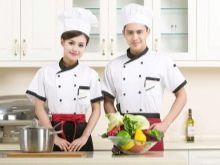

Varieties
If we talk about the types, then the main ones are casual and ceremonial uniforms. In the first, as the name suggests, the chef will work every day, while the second is intended for special occasions, for example, when you need to go out into the hall to the visitors. Most often, a suit includes trousers, a jacket or tunic, and a headdress. The suit should be loose enough so that there is no feeling of stiffness in movement.
Jackets come with long or short sleeves. If the sleeves are wide, the sleeves should have Velcro or buttons that serve to fix these items of clothing. The jacket assumes the presence of wide, convenient pockets. They can also be found on the apron, the use of which is no less advisable. The apron allows you to protect the main clothes from dirt, and in general it looks very organic.
The collar is usually high, but it can be replaced with a special neckerchief.
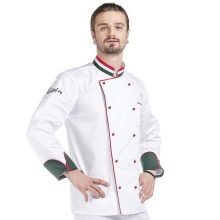


The length of the tunic and apron should be about the middle of the knee for the cook. Buttons are usually absent, fasteners are mostly concealed. When it comes to the color of the chefs' clothes, the undeniable classic is white. However, this is not required. A number of restaurants are developing their own signature uniforms. It can have various shades and be complemented by bright elements.
Famous establishments prefer to place their logos on the clothes of the service personnel. This is especially true for chefs in those cases when they go out into the hall to communicate with visitors or the kitchen is open. Distinguish between male and female cook uniforms. However, the fair sex often abandon skirts in favor of more comfortable and practical trousers., which visually differ slightly from men, as they look more sophisticated and elegant. The same goes for jackets.
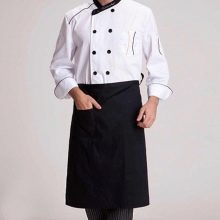


A headdress for chefs of any skill is a must-have item of clothing... It can be a small cylindrical hat (cap), a special protective headscarf or a chef's beret. The main thing is that under the headdress you can reliably and completely remove hair... In noble institutions, even special insignia for qualifications have been introduced, including this is reflected in clothes and headdresses. Male chefs should also wear face masks if they have beards or mustaches.
In addition, one cannot fail to say about shoes. She has a special cut. A prerequisite is the presence of an orthopedic base. The sole of the shoe should not slip. Materials should be selected to allow air to pass through. Special footwear for kitchen workers is called "clogs". In them, the legs, on which the culinary specialist has to spend a lot of time, get tired much less.
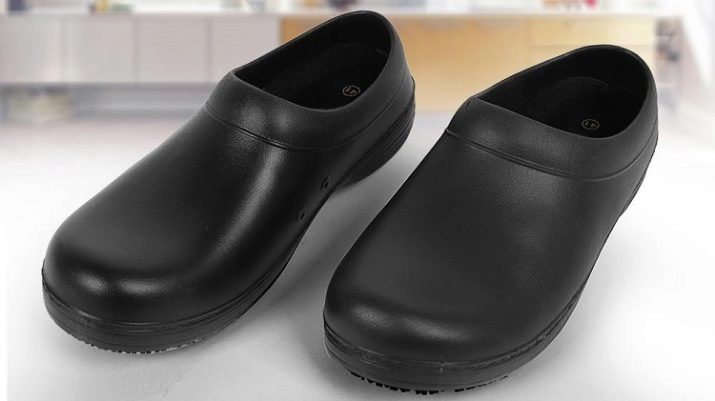
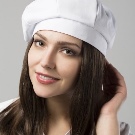




Materials (edit)
If we are talking about overalls, the standards for the material of manufacture are necessarily prescribed in GOST and the requirements of Rospotrebnadzor. The main conditions that such a fabric must meet are as follows:
- high strength;
- environmental friendliness;
- high wear resistance while maintaining a presentable appearance for a long time.
It should be said that synthetics are highly resistant to external influences. But at the same time, its disadvantages are a high level of electrostaticity and reduced hygroscopicity. Cotton materials boast excellent heat transfer. In addition, they are pleasant to touch with the body and are very comfortable. The disadvantages include the ability to wrinkle strongly and wear out quickly enough due to frequent washings.


There are many modern materials on store shelves. Mixed ones are very popular. Consumers believe they combine the core strengths of both synthetic and natural fabrics. They are durable, perfectly tolerate external adverse influences, and also usually have a special water-repellent impregnation. Are also in great demand twill and poplin.
A complete culinary uniform includes a hat, jacket, trousers, apron and towel. All of these things must be made from environmentally friendly materials that are allowed when working with food.
It is optimal if the fabric will also protect a person from heat and steam. Another positive property is hypoallergenic.
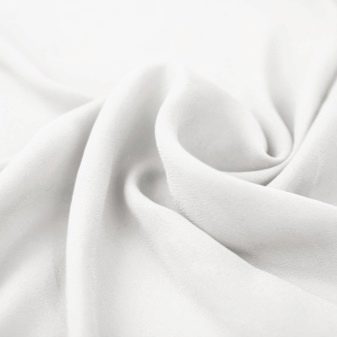

Selection rules
To choose the right overalls for a cook, you need to follow some guidelines. For example, we must not forget about the presence of a headdress. It is imperative for kitchen staff with long hair to tidy up. The use of a disposable cap has become very convenient. Outerwear should be knee-length. Sleeves are supplied with buttons or Velcro. All fasteners on suits must be hidden, and the presence of buttons is unacceptable. Patch pockets are located at the bottom.
To adjust the size, the uniform has elastic bands or special tightening cuffs. You can use an antimicrobial compound to treat her uniform. It also requires daily washing, so don't choose particularly lightweight fabrics. When choosing shoes, you need to check so that the sole does not slip. Having a firm toe box will help protect your foot from possible injury, for example, if a heavy object falls from above.


In the next video, you will find a complete overview of the chef's uniform.








